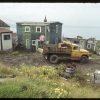KJIPUKTUK (Halifax) – A Vancouver company is getting ready to mine for gold in rural Nova Scotia, starting off with an open pit mine, with at least three others on the Eastern Shore in the planning stages.
To alleviate environmental concerns a local group champions stringent monitoring of the project at Moose River Gold Mines, and better safeguards for future mining developments in the area.
Atlantic Gold Corporation has hired 140 workers and construction is well underway, the CBC reports. All the required environmental permits are in place, and the owner expects the first ore to be processed in late summer of next year.
“Jobs are important. But jobs are not the only thing that matters.”
Most residents believe this is good news. After all, jobs are at a premium in rural Nova Scotia.
Barbara Markovits, one of the driving forces behind the Eastern Shore Forest Watch Association, a group that has advocated for more stringent environmental safeguards around the project, understands that.
“We know jobs are important. It doesn’t matter if the land will be in great shape in 50 years if you can’t feed your family today,” she says. “But jobs are not the only thing that matters.”
“We’re emphasizing a watershed protection approach. Prevent, rather than fix problems after the damage has been done,” says Markovits. “We understand that Nova Scotia wants mining, but our group wants to make it safer.”
The polishing pond, the final treatment of effluent before it is put into the public waterways, is 200 meters from Scraggy Lake, which sits at the the top of Ship Harbour Long Lake Wilderness Area, Markovits says.
The mine effluent may not meet water quality guidelines, but even if it does, some contaminants – mercury, arsenic, lead, cyanate – and nutrients in the form of nitrates will be constantly released into Fish River, the group cautions. This will affect the entire watershed through Lake Charlotte all the way to Ship Harbour.
Wildlife and fish could become contaminated, and released nitrates could trigger algal blooms and fish kills, says Markovits. Or the dam may breach, as it did at the much larger Mount Polley site in British Columbia, causing a full blown environmental disaster.
Focus on monitoring
Now that approvals have been granted for the Moose River Gold Mines site, the Eastern Shore Forest Watch Association emphasizes the importance of monitoring.
Our group started monitoring and analyzing the water in Scraggy Lake since 2008, says Markovits. We have been looking for traces of arsenic and copper, and so far it is clear.
We’d like this monitoring to be regular, frequent, done in the proper locations, and without mixing of the various samples after the fact. We also want results posted on line immediately, not weeks later, Markovits says.
More development coming
Markovits is hopeful that further mining developments will be better scrutinized than was the case with the Moose RIver Gold Mines site. This belief will be put to test soon, as the same Atlantic Gold Corporation wants to open an additional site at Beaver Dam near Sheet Harbour.
Risks are similar, says Markovits, but with an additional issue in the mix. Atlantic Gold is planning to process the ore not on site, but at its Moose River Gold Mines location.
That means that the lifespan of the Moose River Gold Mines site will be extended by three years. It also means that heavy trucks will travel the Eastern Shore roads at a rate of 370 trucks daily, 350 days per year, for three years. That’s one truck every two minutes, Markovits suggests.
This time the proposed mine site will be approved not by the provincial Department of Environment but by the Canadian Environmental Assessment Agency (CEAA).
Markovits thinks that an encouraging sign. “They have the scientists there, and a better mechanism to address community concerns, issues such as water quality, wildlife impacts, concerns around endangered species,” she says.
The group received a small amount of funding to respond to the company’s Environmental Impact statement, now expected to be filed in January. The group already organized two community meetings, one in Oyster Pond and one in Sheet Harbour, to inform the public and gather local information.
“We want not just best practices, we want best practices plus. We want to make any goldmine here as safe for the workers and the environment as possible, and then some. That’s our position,” Markovits says.
If you can, please support the Nova Scotia Advocate so that it can continue to cover issues such as poverty, racism, exclusion, workers’ rights and the environment in Nova Scotia.




Check out the plan for Cochrane Hill Mine by this same company, All water flowing off this site enters St Mary`s River !